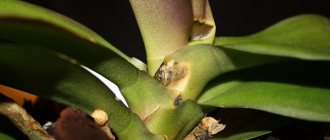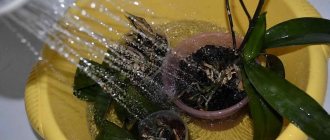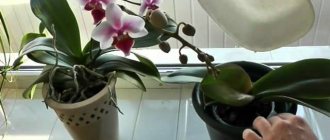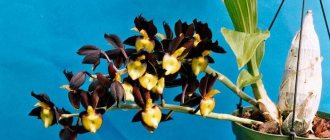What happens to a flower if it is transplanted?
Experts say that replanting an orchid is stressful . It is quite natural that the plant will be sick at first, and the growth of the root system and leaves is also possible. And the gardener’s task is to make this period easier for the flower.
Important : The best time to transplant an orchid is spring, since it is in spring that the roots and leaves of the plant begin to gain strength and grow vigorously.
It is at this time of year that the adaptation period of the flower to the new pot and substrate will be most successful (read more about choosing a pot and soil here). But you should not perform any manipulations with the orchid during flowering: it can shed all the flowers and buds. Such measures should be resorted to in extreme cases, when the entire plant is in danger of death.
Read more about whether it is possible to transplant a beauty when it has released an arrow, read here.
Reasons for yellowing of leaves after transplantation
After replanting, the orchid leaves may turn yellow. Several reasons for this condition:
- The size of the flower container is incorrectly selected;
- The soil does not match the quality, layout or type;
The leaves of an orchid may turn yellow due to improper care. - Maintenance is broken : Watering;
- Lighting;
- Direct sunlight;
- Temperature.
The edges of the orchid's leaves may also turn yellow.
What to do?
Find the cause and try to correct it as quickly as possible. Carry out the transplant procedure again, fulfilling all the necessary requirements corresponding to the biological properties of this type of orchid.
How to avoid?
To avoid mistakes when transplanting, you must follow the step-by-step instructions of experienced gardeners. Study the biological characteristics of the species. Strictly follow care instructions.
How to care for a plant that has undergone this procedure?
An orchid in a stressful state requires increased attention , as well as care and attention. But you shouldn’t be too zealous: a capricious flower may not “understand” overprotection. In order for the flower recovery period to be successful, after transplantation the plant needs to create an atmosphere of peace so that it can recover from the stress it has experienced: the orchid is placed in a shaded room, without being moved from place to place, and watered moderately according to a certain scheme.
Problem with a blooming orchid
During flowering, the problem may occur with uncomfortable conditions and care. In some varieties of orchids, the natural discharge of biomass occurs during the flowering period, so there is no need to worry , knowing the biological characteristics of the plant and its development cycles.
A blooming orchid's leaves may turn yellow due to improper care.
In other cases, if the leaves of a flowering orchid turn yellow, you should be careful to find out the reason :
- Lighting;
- Watering;
- Water quality;
- Feeding.
What to do?
- Try to find out the reason;
- Depending on the stage and depth of yellowing, take measures to eliminate it.
The orchid will begin to shed flowers if the foliage turns yellow en masse , as there will be a noticeable decrease in photosynthesis and nutrition. If there is a single yellowing, you should wait until the leaf is completely dry and only then remove it.
Subsequent actions depend on the severity of the cause . But, with proper care and the absence of diseases, the yellowness of single leaves does not have a significant effect on the development, growth and flowering of a flowering pet.
Prevention measures
With natural aging, yellowing of the leaf cannot be prevented. The plant will shed old leaves and, after dormancy in the active phase, grow new ones .
Following the rules of care will help prevent yellow foliage from appearing.
- First of all, this concerns a balanced sequence of watering with distilled or settled water.
- Strictly follow the feeding rules.
- Do not overfeed with fertilizers.
Yellowing may cause:
- Lack of potassium;
- Or too much calcium.
Well-regulated lighting without direct sunlight plays an important role
Advice! You should not change the position and place of growth in this phase.
Any movement causes stress in the plant and, accordingly, disruption in development cycles.
Step-by-step instructions for care at home
- Immediately after transplantation, the orchid should be placed in a room with diffused lighting for 7 to 10 days. In the room it cannot be moved from place to place, but you need to choose one permanent position. Experienced florists advise: it is better if the flower is located on the eastern window. Direct sunlight on the leaves of the plant should be avoided; for this, the window can be covered with a translucent matte film.
- Pay attention to the temperature regime: the thermometer in the room should not rise above +20C-+22C.
- The first watering after transplantation must be carried out after 4 - 5 days, the next - no earlier than 14 days. Recommended water temperature is +35C-+40C.
The flower needs this time in order for the damage that the flower received when moving it to another container to heal. And also such a technique will make it possible to reduce the risk of pathogenic microorganisms entering the root system , which will certainly cause epiphyte disease.
Watering
There are several ways to water an orchid. Experienced gardeners advise that the first watering after replanting should be done with a shower, thereby creating something similar to a tropical downpour. For this:
The flower is placed in a bath and a stream of water is directed at it at a temperature slightly higher than room temperature.- After this, the plant remains in the bath for 15 - 20 minutes to drain excess water.
- After this procedure, the leaves must be wiped with a napkin.
You can also water the orchid by immersing the pot in a basin of water , then it enters the substrate through holes in the bottom and walls of the container. Another way is to water with a thin stream from a watering can until water begins to flow out of the holes. An important condition is to be sure to drain all excess water from the pot!
It is recommended to spray the leaves daily with warm boiled water from a spray bottle, which helps speed up the healing process of wounds received during transplantation. In this case, be sure to ensure that drops of water do not remain in the axils of the leaves. The average duration of this procedure is 1 month. The preferred time for spraying is early morning. If the weather is hot, then the number of sprays per day can be increased to three.
A little more about watering. For orchids, you should use only soft or moderately hard water with an acidity level of pH5 . The observation of the grower can help determine these indicators (just look at the layer of scale in the kettle: the larger it is, the higher the hardness) and indicator strips. For the latter, you should go to a specialized flower shop, where you can buy oxalic acid, which in a ratio of 1/8 tsp. 5 liters of water will help cope with hardness.
We recommend watching a video about the first watering of an orchid after planting:
Top dressing
Since the new substrate is rich in nutrients, experienced gardeners recommend feeding the orchid for the first time no earlier than a month later. In addition, the root system, injured during transplantation, cannot fully absorb all nutrients, which can lead to the creation of unfavorable microflora in the pot.
For feeding, it is better to use complex preparations intended only for orchids and purchased at a flower shop. For example, “Kemira Lux” (1g per 1 liter of water) or “Bona Forte” (10 ml per 1.5 liter).
In any case, it will not be superfluous to re-read the instructions for these fertilizers. The resulting liquid is watered over the orchid until the water saturates the substrate and begins to pour into the pan. Fertilizing is done during the period of active plant growth, that is, when a new leaf is formed.
Why do phalaenopsis leaves dry and turn yellow and what to do about it?
The health of any plant is influenced by a lot of factors, so the reasons for wilting and yellowing of phalaenopsis leaves can be completely different. Although the vast majority of these reasons, one way or another, relate to one or more of the factors listed below.
Violation of the rules for applying fertilizers and watering
Incorrect watering or fertilizing are one of the most common causes of yellowness on leaves. It can occur due to a lack of moisture, its excess, or due to improper watering.
It happens that novice gardeners overwater the plant. As a result, the substrate absorbs a lot of moisture, which interferes with the breathing of the root system. This circumstance leads, in turn, to the formation of root rot. In addition, an overly humid environment is a favorable factor for the development of fungal diseases.
Insufficiently experienced gardeners can draw conclusions about the need for watering based on the dry bark located on the surface of the substrate. However, these pieces located on the surface dry quite quickly, while the inside of the substrate is still well moistened.
Signs of overwatering phalaenopsis:
- Almost all of the orchid’s leaves have turned yellow, not just the lower ones;
- the surface of the leaves is constantly moistened, the foliage itself acquires a soft structure;
- the foliage, less often the trunk and root system, become covered with dark spots;
- the buds acquire a rusty tint, after which they dry out and crumble;
- the plant rotates freely in the pot, it can be pulled out without making any effort at all.
Important! It is better to plant orchids in transparent pots, since this makes it possible to quite accurately determine the level of humidity of the substrate
"
approximately
"
.
If you are sure that the reason for the appearance of yellowness on the foliage is that the plant is flooded with water, remove the flower from the pot, remove the damaged (blackened, rotten) parts of the root and replant it in another substrate.
The main sign of insufficient watering is yellowed lower leaves, while the flower looks quite healthy. Moisture deficiency can occur due to an incorrectly chosen irrigation method. Perhaps the water that was poured on the flower from a watering can quickly leaves through the drainage holes, without having time to nourish the roots. As a result, young foliage, which is in greater need of nutrients, takes them away from mature leaves.
Eliminating the consequences of insufficient watering is quite simple: to do this, you need to moisten the plant using the immersion method. After 10–15 days of such watering, the orchid will recover.
Video: Causes of yellowing of phalaenopsis and how to save the plant
Another reason for watering-related yellowness may be too high water hardness. Watering with water with a high salt content leads to salinization of the substrate. If this is the reason for the yellowness, the substrate should be replaced, and for irrigation use settled tap water diluted with distilled water in a 1:1 ratio.
Excessive or insufficient feeding also quite often causes the formation of yellow spots. Both extremes are dangerous.
If the yellowness of the foliage is associated with improper application of fertilizers, the following measures should be taken:
- If there is a lack of fertilizer, you just need to feed the plant with special preparations for orchids (“BonaForte”, “Cameleon”, “Kemira Lux”, etc.). Read the instructions carefully and start feeding the flower with half the indicated dose.
- If the appearance of yellowness is a consequence of excessive fertilization, the flower should be transplanted into another substrate as quickly as possible. If some circumstance prevents you from carrying out the procedure immediately, it will be necessary to do this as soon as possible, and rinse the roots with a weak stream of tap water for 20 minutes.
Important! Hybrid phalaenopsis is much less demanding in terms of light and temperature conditions, proper watering and air humidity than varietal phalaenopsis. If you are just starting to deal with these flowers, opt for a hybrid.
Incorrect location
The leaves may also turn yellow due to the inappropriate location of the flower pot. As mentioned above, the orchid prefers places with light shade and does not like open sun. In principle, a flower can grow normally in the shade, under other suitable conditions (temperature, air humidity, watering), but it will not bloom as intensely and for a long time.
If you find yellowed areas on the leaves and are sure that the cause of the problem lies in high-intensity lighting, move the plant to a more shaded area. There is no need to remove yellow areas from the leaves; with a normal level of light, the yellowness will soon disappear.
Closely located radiators can negatively affect the condition of the flower. Additional heating generally creates problems with moisture in winter, and if the flower is on the windowsill above the radiator, this circumstance can have a detrimental effect on the plant. In any case, there is only one solution - move the flowerpot with the plant to another place.
Unsuitable growing container
This is a fairly common reason why leaves may turn yellow. With growth and development, the flower requires a larger pot, since the previous one is already too small for its root system. The solution to the problem is simple: just transplant the orchid into another container, larger in size and diameter.
Also find out what to do if phalaenopsis does not bloom.
In this case, you should choose a pot whose diameter of the upper cut (neck) is no more than 2 cm larger than the previous diameter. Otherwise, the soil may remain wet longer, and excess moisture, in turn, can cause root rot.
Possible diseases and pests
Yellowed leaves and other parts of the orchid can result from the plant being damaged by diseases and pests:
- Fusarium. Favorable conditions for the appearance of fungus are excess moisture and low temperature. The foliage turns yellow, curls up, and then becomes dark. Fusarium is contagious, so the affected flower should be isolated from healthy plants. The affected areas are removed, treated with an antiseptic (alcohol, brilliant green), and “Fundazol” is used for treatment according to the instructions (approximately once every 5–7 days).
- Bacterial and fungal infections. The cause may be excessive watering or infected flowers. You can find out that your flower is affected by such an infection by the following signs: yellow leaves begin to darken and become soft to the touch, the surface becomes covered with ulcers. Remove the affected areas of greenery and root system from the diseased plant. Treat the cut areas with iodine solution or special antiseptics, after which you should move the flower to another substrate.
- Root mite. The appearance of a pest can be recognized by the unhealthy state of the root system and shoots. The flower is transplanted into another substrate, having previously treated the plant with Agrovertin or Karbofos, as indicated in the instructions.
- Whitefly. The fact that the parasite has taken a fancy to your phalaenopsis will be indicated by a white coating on reddened or yellowed leaves. Try to help the flower in the following way: prepare a solution of laundry soap, treat the plant with it, and then use Actellik.
Diseases: control and prevention measures
Frequent waterlogging of the orchid and poor cultivation conditions contribute not only to rotting of the roots, but also weaken the orchid’s immunity and lead to various leaf diseases :
- Fusarium. A common disease caused by Fusarium fungus: appears on the leaves as dirty gray spots. The plant is isolated and optimal conditions are created; in case of severe infection, it is treated with a fungicide.
- Wet bacterial rot : the disease is caused by bacteria p. Pseudomonas. A transparent spot forms on the leaves, and over time it becomes mushy. Diseased parts of the plant are cut off, the sections are smeared with iodine, and in case of severe infection, they are sprayed with Bordeaux mixture.
The main prevention of all diseases is the creation of optimal growing conditions for the orchid, as well as proper care of the plant. Compliance with these rules is the key to the well-being and lush flowering of the orchid.
Natural process
The owners of tropical orchids are well aware of their characteristics - they develop only a few leaves, the maximum number is 10-12. Over the course of a year, a healthy and vigorous plant forms 2-3 new leaf blades.
Lifespan is about 3 years, sometimes more. Then there is a natural replacement with new leaves, and the old ones die and fall off, having exhausted their life resource.
Important: if the lower leaves turn yellow, but there are no new forcings, then the flower experiences light starvation or a lack of minerals.
As a result, every 3-4 years phalaenopsis sheds the bulk of its green mass for renewal.
Another interesting nuance is related to the conflict of climatic zones. In the plant's homeland, in tropical forests, changing seasons lead to an increase or decrease in precipitation. At the same time, the temperature and length of daylight hours remain the same, so orchids do not require a rest period. They bloom almost continuously and form new flower stalks to replace the withering ones.
In European latitudes, most plants go into a kind of torpor, hibernation, in winter. Only fans can completely recreate natural living conditions in a separate room, or specialists in special greenhouses.
Flowers inevitably have to adapt to a different rhythm of life. It is rare in phalaenopsis, but there are cases of retiring during the 2-3 coldest winter months. After flowering, you can see how the aerial roots are covered with a whitish film, and the leaves die off - this is a sign of stopping growth and waiting out unfavorable conditions.
In this case, the pot is moved to a dark, cool place and watered very rarely, allowing the plant to rest. At the first signs of the formation of a new leaf, they switch to the usual care regime and return the pot to the southern window.











